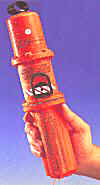So, you have abandoned your sinking GMDSS vessel, and you find yourself in a lifeboat or liferaft.
What now ?Well the GMDSS doesn't stop yet - there are specific GMDSS radio systems developed for operation from survival craft.
These systems are designed to alert rescuers to your plight and guide them to your location.

A SART is a self contained, portable and buoyant Radar Transponder (receiver and transmitter).
SARTs operate in the 9 GHz marine radar band, and when interrogated by a searching ship's radar, respond with a signal which is displayed as a series of dots on a radar screen.
Although SARTs are primarily designed to be used in lifeboats or liferafts, they can be deployed on board a ship, or even in the water.
SARTs are powered by integral batteries which are designed to provide up to 96 hours of operation.
When activated, a SART responds to a searching radar interrogation by generating a swept frequency signal which is displayed on a radar screen as a line of 12 dots extending outward from the SARTs position along its line of bearing.
The spacing between each dot is 0.6 nautical miles.
As the searching vessel approaches the SART, the radar display will change to wide arcs. These may eventually change to complete circles as the SART becomes continually triggered by the searching ship's radar.
Some slight position error will also be caused by the SART switching from receive to transmit mode.
SARTs will also provide a visual and audible indication to users when interrogated by a seating radar.
The range achievable from a SART is directly proportional to its height above the water.
A SART mounted at 1m (ie: in a liferaft) should be able to be detected at 5 nautical miles by a ship's radar mounted at 15m.
The same SART should be able to be detected at 30 nautical miles by an aircraft flying at 8000 feet.
GMDSS vessels from 300 to 500 GRT are required to carry 1 SART, and vessels over 500 GRT are required to carry 2 SARTs.
 <<----Typical GMDSS VHF portable transceivers
<<----Typical GMDSS VHF portable transceivers
These units are designed to allow communications between searching vessels and survivors in liferafts. They operate on the VHF marine band in voice mode. DSC capability is not fitted.
Performance standardsThe IMO performance standard requires that the equipment:
GMDSS vessels from 300 to 500 GRT are required to carry 2 VHF portables, and vessels over 500 GRT are required to carry 3 SARTs.